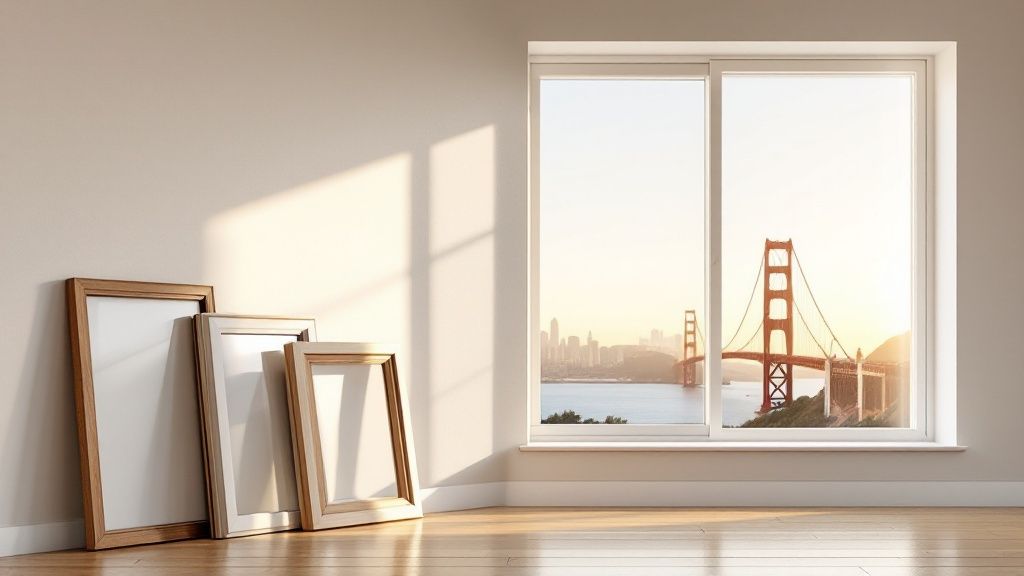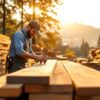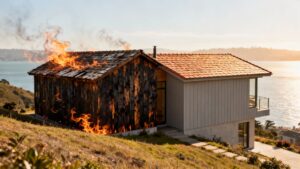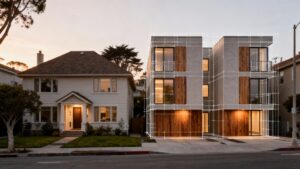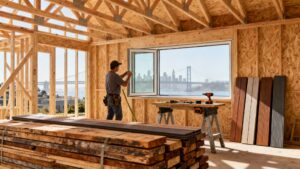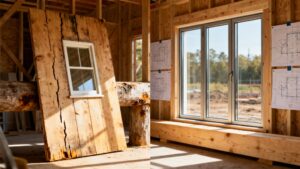Choosing the right windows for a Bay Area home means balancing looks, performance, and our local climate. The best approach is to select materials like fiberglass or high-quality vinyl. They hold up well against moisture and salt air from the coast.
You also need to make sure the window's energy ratings meet California's Title 24 requirements for your specific area. This ensures your investment is durable, follows the rules, and helps keep your energy bills low.
A Guide to Selecting the Right Bay Area Windows

Picking new windows in the Bay Area is more than just about looks. It’s a big investment in your home's comfort, efficiency, and value. Our region has many different microclimates.
You have the constant fog along the San Francisco coast, the sunny hills of Berkeley, and the changing weather in Oakland. A window that works well in one neighborhood might not be right for another. Understanding these local factors is key to making a good choice.
Key Factors for Choosing Windows
For builders, remodelers, or homeowners, the number of window options can seem endless. You need a window that fits your home’s style and can handle challenges like salt air, temperature changes, and California's strict energy codes.
This guide will help you understand how to choose windows by focusing on what matters most. We will cover materials that last, energy ratings that save money, and styles that suit our diverse local architecture.
For many homeowners, energy-efficient upgrades are a top priority. In the Bay Area, these improvements not only enhance comfort but also significantly boost a property's appeal in our competitive real estate market.
Before we dive in, here are the main things to consider:
- Climate Resilience: How will the window material handle humidity, salt spray, and temperature changes? You want to avoid warping, cracking, or rust over time.
- Energy Performance: Does the window meet or exceed California’s Title 24 energy standards? Pay close attention to the U-Factor and SHGC ratings for your climate zone.
- Architectural Style: Does the design match your home's look? Whether it's a historic Victorian or a modern home, the windows should fit in.
- Long-Term Maintenance: Do you prefer low-maintenance options like fiberglass or vinyl, or are you okay with the regular upkeep that wood requires?
- Overall Budget: Think about both the upfront cost and the long-term value. This includes energy savings and the equity it adds to your home.
We created a simple table to show the most important factors. This is a great starting point for discussions with your contractor or a supplier like Truitt & White.
Quick Guide: Key Decision Factors for Bay Area Windows
| Factor | Why It Matters in the Bay Area | Top Options |
|---|---|---|
| Material Durability | Coastal fog and salt air can damage metal and wood. Materials must resist moisture and sun exposure. | Fiberglass, high-quality vinyl, and properly treated wood with protective cladding. |
| Energy Efficiency | Meeting Title 24 codes is required. The right U-Factor and SHGC ratings help manage heat loss and gain. | Double-pane windows with low-E coatings and argon gas fill are the standard. |
| Condensation Resistance | High humidity near the coast can cause condensation, leading to mold and water damage. | Look for windows with warm-edge spacers and non-conductive frames like fiberglass or vinyl. |
| Architectural Integrity | Windows must match various styles, from classic Victorians in San Francisco to modern homes in Berkeley. | A wide range of styles is available, but material choice can affect frame thickness and design. |
This table covers the basics, but every project is different. The goal is to find the right balance for your home, climate zone, and budget.
Matching Windows to Bay Area Climates and Building Codes
The Bay Area isn't just one climate. It's a mix of very different microclimates. A window perfect for hot Walnut Creek might be a bad choice for foggy Daly City.
Homes near the coast face unique challenges. The salty air can damage certain frame materials over time. You also have to deal with moisture and big temperature swings. You need windows that won’t warp or expand under these conditions.
Understanding California's Title 24 Energy Codes
In addition to weather, every window in California must meet the state’s strict Title 24 energy standards. These codes are designed to make homes more efficient and lower utility bills.
This means you need to know two key ratings found on the National Fenestration Rating Council (NFRC) label on every new window:
- U-Factor: This number shows how well a window prevents heat from escaping. A lower U-Factor means better insulation. This is important for keeping homes in places like Berkeley and Oakland warm in the winter.
- Solar Heat Gain Coefficient (SHGC): This measures how much of the sun's heat a window blocks. A lower SHGC is better for sunny areas like Concord, as it helps keep the house cool in the summer.
According to the California Energy Commission, standards are always being updated to improve building efficiency. It's smart to choose windows that exceed current standards. This adds long-term value and comfort to a home.
Benefits of Energy-Efficient Windows in the Bay Area
Your job is to match these ratings to your project's location. For a coastal home, a low U-Factor is a priority to keep heat in. For a hot inland home, a low SHGC is key to block summer heat.
The entire window—frame, glass, and seals—must work together. For more tips on making your installation airtight, check out our guide on weatherproofing windows and doors. Choosing windows that fit the local climate and meet Title 24 is not just about passing inspection. It’s about building a comfortable and durable home that will perform well for years.
Comparing Window Materials for Bay Area Conditions
The frame material is the foundation of your window's performance, appearance, and lifespan. In the Bay Area, this choice is extra important. The material must withstand everything from foggy, salty air to bright sun.
Let's look at the most common options. We'll see how they perform in real-world conditions, from Sausalito's salt spray to Berkeley's historic homes.
Fiberglass: The Durable All-Rounder
Fiberglass windows are a top choice for many builders and homeowners. This material is very strong and stable. It doesn't expand or contract much with the Bay Area's temperature swings, which helps prevent drafts.
Fiberglass is also resistant to moisture, salt, and rot, making it perfect for coastal homes. It won't rust or warp, offering a long-lasting, low-maintenance solution.
Vinyl: A Practical and Efficient Option
High-quality vinyl is popular for its mix of performance and value. Modern vinyl windows offer great energy efficiency and require very little maintenance. They never need painting and are easy to clean.
Vinyl is also non-corrosive, which is a big advantage in our damp climate. While not as rigid as fiberglass, premium vinyl provides reliable performance and is a smart investment.
Wood: Timeless Appeal with a Catch
Nothing matches the classic, warm look of wood. It's a natural insulator and a favorite for historic homes in neighborhoods like Berkeley and Oakland.
But wood requires regular maintenance. It needs to be painted or stained to protect it from moisture, which can cause swelling and rot. A good compromise is a wood-clad window, which has a durable aluminum or fiberglass exterior and a beautiful wood interior.
Aluminum: Sleek and Modern, but Less Efficient
Architects often choose aluminum for modern projects. The frames are light, strong, and can be made very thin for a sleek look that maximizes glass.
The main downside is thermal performance. Aluminum conducts heat and cold easily, making it the least energy-efficient option unless it has a thermal break. For most Bay Area climates, other materials provide much better insulation.
Window Material Comparison for Bay Area Homes
| Material | Pros | Cons | Best For |
| :— | :— | :— |
| Fiberglass | Extremely durable, low maintenance, resists moisture and salt, highly energy efficient. | Higher initial cost than vinyl. | Coastal areas, modern homes, and anyone wanting long-term durability with little upkeep. |
| Vinyl | Cost-effective, excellent energy efficiency, very low maintenance, non-corrosive. | Can be less rigid than other materials, limited color options on some models. | Budget-conscious projects, rental properties, and homeowners seeking a practical, efficient solution. |
| Wood | Classic, high-end look, natural insulator, can be painted or stained to match any style. | High maintenance, can rot or get pests if not maintained, can be expensive. | Historic renovations, traditional homes, and projects where classic style is most important. |
| Aluminum | Strong and lightweight, allows for thin frames and modern designs, durable. | Poor thermal insulation (unless it has a thermal break), can be prone to condensation. | Contemporary homes and large window walls where slim frames are desired. |
Each material has its pros and cons. The right choice depends on your home's needs and your long-term goals.

Upfront costs differ from long-term performance. Costs vary based on quality, style, and features. A standard vinyl window might cost $600 to $1,200 installed, while a premium fiberglass or wood-clad window can run from $1,200 to over $3,000 each. To learn more about what to expect, read our guide on the costs of energy-efficient windows for Bay Area homes.
Calculating the Long-Term Value of New Windows
Upgrading your windows is a smart investment in your property. It's easy to focus on the initial cost, but the real benefits show up over time. High-performance windows are designed to provide financial rewards you will see every month.
That value begins with energy savings. Modern features like double-pane glass, argon gas fills, and Low-E coatings greatly improve your home’s insulation. They keep your home warm in the winter and cool in the summer.
When your home is better insulated, your heating and cooling system works less. According to Energy Star, installing certified windows can lower energy bills by an average of 12 percent nationwide. This means real savings for any Bay Area homeowner.
Boosting Your Home's Resale Value
New windows also offer a great return on investment (ROI). In the competitive Bay Area real estate market, a home with modern, efficient windows is very attractive to buyers. It shows the property is well-maintained, comfortable, and cheaper to own.
This has a real impact on your home's value. Data suggests that window replacement averages about a 70% ROI, making it a smart upgrade. That means if you spend $10,000 on new windows, you can expect to get back around $7,000 in added home value when you sell. You can find more industry reports on California window replacement ROI.
When buyers see new, high-quality windows, they see a home that's been cared for. It’s a powerful signal of quality that can help your property stand out and sell faster.
A Lasting Asset for Your Property
Choosing the right windows is a decision that pays you back for years. Look past the initial price to understand the full financial picture. The combination of monthly energy savings and a boost in property value makes new windows a powerful asset for any Bay Area home.
To get a clearer idea of how features and materials impact your budget, see our detailed guide on the cost of energy-efficient windows. This resource helps you make a choice that fits your financial goals.
Budgeting Your Bay Area Window Project

Creating a realistic budget is the foundation of a successful window project. In the Bay Area, costs can vary a lot based on local factors. Understanding what drives the final price is the first step to good planning.
The total cost depends on a few key things. These include the number of windows, their sizes, and the style you choose. The frame material, glass package, and any custom features will also affect the final price.
Breaking Down the Costs
Don't forget about installation. A simple pocket replacement, which swaps out an old window in the existing frame, is less work than a full-frame installation. A full-frame job involves removing trim to replace the entire unit and costs more.
For historic homes in Berkeley or Oakland, labor costs can be higher. You're paying for the skill needed to install windows perfectly without damaging the home's original character.
Here are the key factors that will shape your final cost:
- Window Quantity and Size: More windows and larger, custom sizes mean higher material and labor costs.
- Frame Material: Fiberglass and wood-clad windows are beautiful but usually have a higher upfront cost compared to high-quality vinyl.
- Glass Package: Upgrading to triple-pane glass, advanced Low-E coatings, or specialty glass for sound reduction will add to the price.
- Installation Type: Full-frame installations cost more than simple insert replacements because they require more labor and materials.
Average Window Costs in the Bay Area
Knowing the local price range helps set realistic expectations. In a market like San Francisco or Oakland, the average window replacement cost is around $1,000 per window.
A standard project of 8 to 12 windows could cost between $7,360 and $13,557. A larger home with 20 to 24 windows might range from $18,000 to $26,400.
A well-planned budget does more than just prevent sticker shock. It helps you prioritize what truly matters, whether that's maximum energy efficiency, a specific architectural look, or sticking to a budget.
As you plan, it can be helpful to understand different project estimation techniques. This knowledge helps you evaluate quotes from contractors. For a personalized estimate, our window replacement cost estimator is a great tool for Bay Area homeowners and contractors.
Working with Window Experts in Berkeley
Making the final decision on windows is a big one, but you don't have to do it alone. You now know about our local climate, which materials work best, and how to budget. The next step is applying this knowledge to your project.
Connecting with professionals who know Bay Area construction makes all the difference. When you're ready, look for companies offering professional window replacement and door replacement services to ensure quality installation. An expert can help turn your vision into a reality that is beautiful, functional, and meets all local codes.
There's simply no substitute for seeing and feeling the products firsthand. A showroom visit lets you compare frame profiles, test the hardware, and really visualize how different styles will look and feel in your own space.
We invite builders, architects, and homeowners to visit our Truitt & White showroom in Berkeley. Our team is here to provide personalized advice for your project, whether it’s a historic Oakland remodel or a new build in San Francisco. We carry top brands like Marvin and Andersen, so you can find the perfect fit.
Let's find the best windows for you. Contact us today to schedule a consultation.
Frequently Asked Questions About Bay Area Windows

Here are answers to some of the most common questions we hear from builders, remodelers, and homeowners in the Bay Area.
What is the best window material for a coastal home?
For homes near the coast in areas like San Francisco or Oakland, fiberglass is an excellent choice. It resists salt spray, moisture, and temperature changes without warping or corroding. High-quality vinyl is another great low-maintenance option that performs well in coastal conditions.
Do I need double or triple-pane windows in the Bay Area?
For most of the Bay Area's mild climate, a high-performance double-pane window with a good Low-E coating offers the best balance of energy efficiency and cost. Triple-pane windows are usually only needed for homes in colder microclimates or when maximum soundproofing is a priority, such as on a busy street.
How do I know if my windows meet Title 24 energy codes?
Look for the National Fenestration Rating Council (NFRC) label on the window. This label clearly shows the U-factor and Solar Heat Gain Coefficient (SHGC) ratings. Our experts at Truitt & White can help you confirm that these numbers meet the specific requirements for your local climate zone.
How long do new windows last?
The lifespan of a window depends on the material. Quality fiberglass and vinyl windows can last 20-40 years with very little maintenance. Wood windows can last even longer but require regular painting or staining to protect them from moisture, which is critical in our climate.
Why is UV protection important for windows?
UV rays can fade your furniture, flooring, and artwork over time, especially in sunnier parts of the Bay Area like the East Bay hills. A Low-E (low-emissivity) coating is a microscopic layer on the glass that reflects harmful UV rays while improving insulation. It's a standard feature on most high-quality windows today.
For even more answers, you can explore our complete Truitt & White FAQ page.


